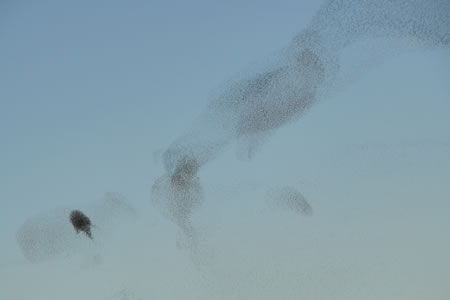

| Spectacle at the Gialova Lagoon | |
Párga (Greece), December 14th 2011
|
|
|
|
|
The small village Gialova, on the west coast of the Greek Peloponnese province, is famous for its lagoon. This lagoon, with the size of around 700 hectares, is known as the wintering place for more than 20.000 migratory birds. Research by the Greek Ornithological organisation found out that 265 of the around 400 birds that are present in Greece, can be found here. We decided to take a look at this lagoon. The location of the lagoon is formidable. It is separated by a thin piece of land from the beautiful Navarino Bay. This bay, with two openings to the open sea, has two more attraction: the picturesque town of Pylos and the dramatically located ruins of the Paleokastro castle. The ruins are located on top of a rock that is in between the open sea and the Navarino Bay. From the ruins you have spectacular views on both the bay and the lagoon. It is winter time and that means that the campgrounds in the vicinity of the lagoon are closed. We decide to park our jeep at the beach of Gialova. It is low season and there are no other tourists. So, the local Greek population is not bothered by us camping wild on their beach. |
|
 |
|
A huge flock of birds at the Gialova Lagoon |
|
The next morning we drive the remaining three kilometres to the small visitor centre of the lagoon, where we arrive at the same time as two busses full of school children. The students are very noisy, probably unconsciously fanned by the accompanying teachers, who are even noisier. The children start their tour with a visit to the visitor centre, which gives us the possibility to take a head start on the trail that surrounds the lagoon. It doesn’t take long before we spot the first Greater Flamingos. They are standing in groups of around 25 individuals in the middle of the lagoon. We have seen these Flamingos before in more tropical situations, but it is also fantastic to see them here in Europe. We take a seat in one of the blinds which gives us a good view over a part of the lagoon where many ducks are present, just as other birds that live on or close to the water. The birds are not aware of our presence which gives us the possibility to observe them thoroughly. We see different species, like the Mute Swan, Pintail, Wigeon, Northern Shoveler, Teal and the always great to see Common Kingfisher. After spending some time in the blind, we continue our walk around the lagoon. We are happy to hear that the school children are at the end of their visit. When the doors of the busses are closed, the peace returns to the lagoon. Later that walk we are very happy to note one of the highlights of that day. On a small piece of dry ground in the lagoon, we spot a Black Stork. We are excited because it is the first time that we see this beautiful stork. It is the only individual we see that day and he made our visit to the lagoon absolutely worth every effort. After we encircled the lagoon, we take a seat a small quiet beach at Navarino Bay where we enjoy our lunch. The weather is perfect and we wait for another hour or so before we return to the blind again. We do not see any new water birds, but we are very satisfied with both the Osprey and the Marsh Harrier. |
|
 |
|
Several beautiful formations |
|
| By the time that the sun is setting, we are treated with a nature spectacle that is unrivalled. Never before did we see such a kind of natural ‘show’. Hundreds of thousand, or even millions of birds, form a dark and huge cloud above a mountain chain at the other side of the lagoon. These birds perform the most fantastic formations. From waves to tornado formations, everything seems to be possible. The size of the group increases even more, before it splits in different subgroups, all with their own choreography. Passing Greeks stop their cars, step out, and watch the spectacle with open mouth. Fantastic! When we look with our binoculars to the groups of birds, we see different birds of prey, in search of an unsuspecting performer. The little birds are so occupied with their formations, that they are not aware of the approaching danger. They probably think: what is the chance of getting caught in such a large group? The chance must be around one in the million.
The spectacle seems to go on forever. The sun isn’t visible anymore and the sky is orange by now. The birds are not thinking about stopping yet. But when they stop, there are probably a couple of Greek farmers that aren’t going to be very happy. These are the farmers whose plantations are selected by the birds to spend the night. Because a visit by more than a million birds is probably not going to be a trouble-free visit for the farmer. © copyright - Babakoto.eu / 2011 |
|